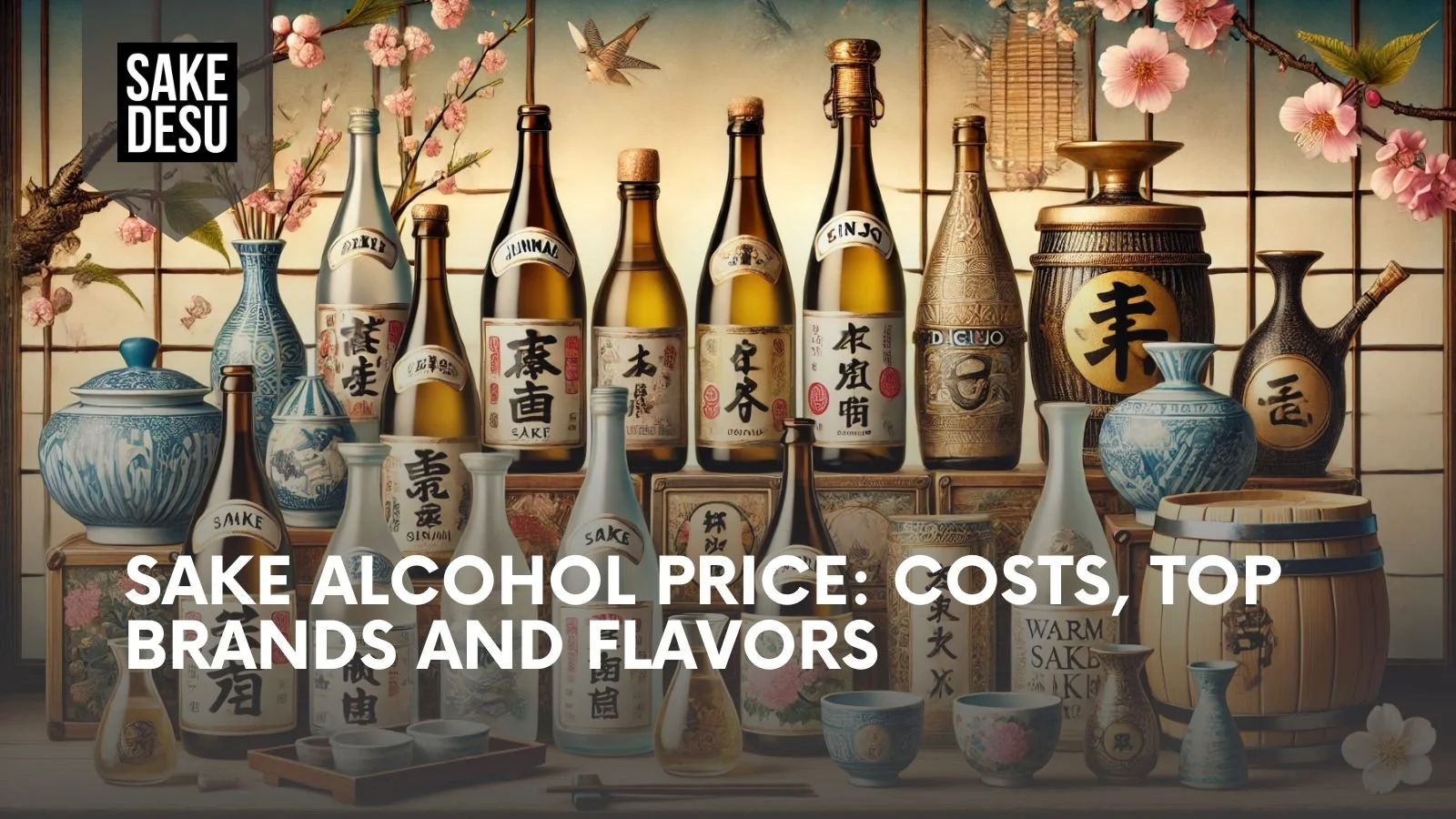Sake Alcohol Price: Understanding Costs, Top Brands, and Unique Flavors
Sake is a traditional Japanese rice wine that has won over drinkers all over the world with its unique tastes and rich cultural history. Because there are so many types of sake and levels of quality, it can be hard to figure out how much sake costs.
Find out what makes sake expensive, how much you can expect to pay, and why it costs what it does in this piece. This guide will help you find your way around the world of sake, whether you're a beginner or an expert. You'll be able to make smart purchases and fully enjoy this delicious drink.
How Much Does Sake Usually Cost?
The price of sake alcohol changes a lot because there are so many brands and levels of quality to choose from. The price of sake usually depends on things like the amount of rice that is polished, how it is made, and how well known the brand is.
The price of sake can run from very cheap to very expensive. Here's a rough idea of the price ranges:
Budget-Friendly Sake: $10 - $20. Common types include basic Junmai and Honjozo.
Mid-Range Sake: $20 - $50. Includes premium sake like Ginjo and some sparkling sake.
High-End Sake: $50 - $100+. Features Daiginjo and aged sake, reflecting exceptional craftsmanship.
Luxury Sake: $100+. Rare and limited editions, often involve meticulous brewing processes.
Factors Influencing Sake Prices
Several key factors influence sake prices:
Rice Polishing Ratio: Higher polishing ratios (Daiginjo) produce more expensive and sophisticated flavors.
Production Methods: Methods that are old and require a lot of work raise costs.
Brand Reputation: Because of their quality and history, well-known sake brands often charge more.
Aging and Rarity: Limited versions and sake that have been aged can make the price go up a lot.
These things affect how much you pay for sake when you buy it online. Knowing about these things will help you decide whether to buy pure sake like Nigori sake or sparkling sake.
Why is Sake So Expensive?
People often think of sake as a pricey alcoholic drink because it is made in a complicated way with high-quality ingredients. This part talks about why some Japanese sake can be so expensive.
Sake starts to ferment with pure water and high-quality rice that have been carefully chosen for their qualities. Polishing the rice gets rid of the top layers, which makes the sake taste better.
Polishing: More rice and work are needed to make Daiginjo, a type of sake with a higher polishing ratio, which drives up the price.
Fermentation: Fine-tuning of the fermentation process makes sure that complex flavors develop.
Brewing Expertise: Professional brewers, who often have years of experience, oversee the brewing process to make sure that high standards are met.
Premium Ingredients and Limited Production
Luxury sake brands use high-quality ingredients and often only make a small amount at a time, which makes it even more expensive and hard to get.
Premium Rice: Varieties like Yamada Nishiki are prized for their sake-making qualities.
Limited Production: Small batches ensure quality but also increase scarcity and price.
Aging: Some sake is aged to develop deeper flavors, similar to hard liquor, which can drive up the price.
When you drink sake, especially high-end varieties, you're enjoying a product that was made with care and follows tradition, which is why it costs more. Knowing about these things helps you see why you should buy the best sake brands.
How Much Alcohol is in Sake?
Sake, which is sometimes called "rice wine," is different from other alcoholic drinks like beer and hard liquors because it has a different alcohol level. The amount of alcohol in sake changes based on the type and how it was made.
Sake usually has between 12% and 20% alcohol, which makes it stronger than most wines but not as strong as hard liquors. There are different amounts of alcohol in each type of sake:
Junmai Shu: Typically has an alcohol content of around 15%-17%.
Ginjo Shu: Similar to Junmai Shu, but can sometimes be slightly lighter.
Unfiltered Sake (Nigori): Often has a creamy texture and ranges from 14%-17%.
Sparkling Sake: Generally lighter, around 12%-15%.
Impact of Alcohol Content on Flavor and Experience
The amount of alcohol in sake has a big effect on how it tastes and how it feels to drink. A sake with more alcohol can improve its flavor profile, making it taste fuller and stronger.
Higher Alcohol Content: This gives the flavor more depth and complexity, making it good for sipping and enjoying slowly.
Lower Alcohol Content: Makes the taste lighter and sweeter, which makes it easier to drink and pair with food.
If you want to choose the best sake for your taste and the event, you should know how much alcohol is in it.
Is Sake a Good Alcohol to Drink?
Sake is a famous alcoholic drink that has special health benefits and comes in a lot of different flavors. It is different from other drinks and hard liquors because of how it is made and the ingredients that are used.
Sake is made from rice, water, yeast, and koji mold. When drunk in moderation, sake can be good for your health in a number of ways:
Antioxidants: Antioxidant-rich amino acids and peptides can be found in sake.
Low in Fat: Since sake doesn't have a lot of fat like many spirits, it may be a better choice for people who want to drink less alcohol.
Nutritional Value: There are a lot of amino acids in sake, which is good for your health.
Flavor Profile and Versatility
The taste of each type of sake is very different from the others. From sweet to dry, light to strong, it can be found.
Versatility: Warm, cold, or at room temperature are all good ways to enjoy sake. It goes well with many types of food and makes the eating experience better.
Popular Brands: Some of the best sake comes from well-known names that are known for making high-quality beer, such as Dassai, Hakkaisan, and Gekkeikan.
No matter if you like a light Ginjo shu or a strong Junmai shu, sake has a lot of different tastes and experiences that make it a good choice for many situations.
Do You Drink Sake Straight?
Sake is a flexible alcoholic drink that can be enjoyed in a number of ways. People usually drink sake by itself, but it can also be mixed with other drinks and given at different temperatures to bring out its full flavors.
It is usual to drink sake straight up. Depending on the type and your taste, it can be served cold, at room temperature, or warm, but not piping hot!
Chilled: Premium sakes like Ginjo and Daiginjo often use this to bring out their delicate flavors and aromas. You can also serve sparkling sake the same way you serve sparkling wine. It should be cold before you open it and pour it into a flute-shaped glass.
Room Temperature: It tastes smooth and balanced and goes well with many Junmai sakes.
Warm: Often enjoyed for its soothing effects, especially in the winter. Fits sakes with a bigger body.
Etiquette and Serving Tips
Knowing how to serve and behave properly when drinking sake straight makes the experience better.
Glassware: Usually, sake is served in small ceramic cups, but you can also enjoy it in wine glasses to fully enjoy the smells.
Pouring: Pouring sake for others rather than yourself is a sign of Japanese hospitality.
Cocktails: Sake drinks are a modern trend. By mixing sake with things like honey or strawberries, you can make unique drinks that suit a wide range of tastes.
By trying these methods, you can fully enjoy the quality and versatility of the different kinds of sake.
Why Does Sake Not Give a Hangover?
Sake is known for being pure because it is made with high-quality ingredients and in traditional ways. It may help you recover from a hangover more quickly than whiskey or cocktails. The careful process of making sake makes it smoother and less likely to give you a hangover.
Quality Ingredients: Sake is only made from rice, water, yeast, and koji mold. It doesn't have any other ingredients or preservatives.
Brewing Process: Because the fermentation process is carefully managed and clean, high-quality ingredients are used, and the drink is pure and has few impurities.
Scientific Insights
Scientific reasons help explain why sake might cause fewer hangovers.
Lower Congeners: When compared to spirits like whiskey, which are often linked to hangovers, sake has fewer congeners, which are byproducts of fermentation.
Smooth Flavors: Sake has a smooth, clean taste that is often called "rich and balanced." This shows that it is of high quality and purity.
When trying different kinds of sake, knowing these things about this Japanese drink can help you see why it might be a better choice for many. Sake is a pleasant beverage that may not leave you feeling too apprehensive, regardless of whether you prefer it chilled or heated.
Final Thoughts
With its long history and societal importance, sake has a lot of different tastes and experiences to offer. Knowing what affects the price and quality of sake can help you make smart decisions and enjoy this one-of-a-kind alcoholic beverage.
Some of the things that affect the price of sake alcohol are the amount of rice polished, how it is made, and the name of the brand.
Price Ranges: From affordable to expensive sake preferences.
Production and Craftsmanship: Higher expenses related to conventional techniques and expensive supplies.
Alcohol Content: Usually between 12% and 20%, which changes the taste and overall drinking experience.
You can find the best sake for your tastes and events by trying out different types and brands. You can better enjoy this ancient art form and make smarter decisions when you buy sake online or try out different brands if you know about its background, production process, and different types.
Frequently asked sake alcohol price questions
-
To keep its freshness, sake should be kept in a cool, dark place. For the best taste, put it in the fridge after opening and eat it within a few weeks.
-
In fact, sake is often added to soups, stews, and marinades to make them taste better. It gives the food a unique depth and flavor.
-
Junmai, Honjozo, Ginjo, and Daiginjo are the main kinds of sake. They are all different in how the rice is polished and how it tastes. They range from light and sweet to heavy and complicated.
-
Think about what kinds of tastes you like, like whether you like sweet or dry sake. You can find the best things to try by reading reviews and suggestions.
-
Traditional sake is made from rice, water, yeast, and koji mold, so it doesn't have any gluten in it. People who are sensitive to gluten can eat it without worry.





